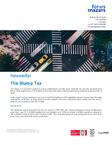The Stamp Tax
In this regard, various questions have arisen about the legitimacy of the legislative decrees issued under the state of exception mentioned, as these must be directly related to the crisis and will lose their validity once the order is restored, as provided by Law 137 of 1994.
Background
The stamp tax was incorporated into the tax system in 1976 with Law, having undergone various modifications since then. Law 1111 of 2006 modified the rate (initially set at 1.5%) as follows: in 2008 it would be reduced to 1%, in 2009 to 0.5%, and from 2010 onwards to 0%. Thus, even though the tax has remained in force, since 2010 it has had a rate of 0% with certain exceptions.
Characteristics of the Stamp Tax
The current regulations (Article 514 of the Colombian Tax Code (hereinafter “C.T.C.”) establish the conditions and rates, as well as the applicable exemptions and particularities.
It is worth mentioning that the stamp tax is a documentary tax that applies to public or private documents that record the constitution, existence, modification, or extinction of obligations.
It is a formal tax, as it is only taxes written forms, and it is direct, aimed at taxing the recipient of the tax, that is, who engages in the act or contract.
Additionally, this is an instantaneous causation tax, which means that it arises at the moment the document is signed.
Essential Elements
The taxable event of the stamp tax is the granting or acceptance of documents in the country or abroad that are executed in the national territory or that generate obligations therein, with an amount exceeding 6,000 TVU (COP $298,794,000). These documents must involve a public entity, a legal entity or equivalent, or a individual who is a merchant and who, in the previous year, had gross income or gross assets exceeding 30,000 TVU (COP $1,493,970,000).
There are some special rules, such as in successive execution contracts where the total value of the periodic payments to be made during the term of the agreement, or in acts or transactions of indeterminate value where the amount will be as specified in the regulations governing the tax and not the estimation of the parties.
The subjects of the Stamp Tax are the Nation (DIAN) as the active subject and the grantors, drawers, acceptors, issuers, or subscribers of the documents as passive subjects.
Regarding withholding agents, these include notaries, entities supervised by the Financial Superintendence of Colombia, public law entities, state industrial and commercial enterprises, and mixed economy companies with a degree of priority in each particular case.
As for the rate, it is 1%. However, through Law 2277 of 2022, paragraph 3 was added to Article 519 of the C.T.C., establishing that for documents elevated to public deed in the transfer of real estate, a special progressive rate of 0%, 1.5%, and 3% will apply, depending on the value of the transfer in TVU.
Exemptions to the Tax
There are several exemptions to the tax, such as exchange bills, endorsements of securities, real estate sale promises, commercial offers, acceptance of the same through purchase orders, employment contracts, accessory contracts, and other specific documents detailed in Article 530 of the C.T.C.
Other Considerations
The paid tax will be fully deductible from the income tax base when it has a causal relationship with the income-producing activity, under the terms of Article 115 of the ET.
DIAN has broad powers to investigate compliance with the tax; inaccuracies will be sanctioned at 160% of the higher determined value.
Let's remember that Decree 175 of 2025 is applicable from February 22, 2025, to December 31, 2025.

